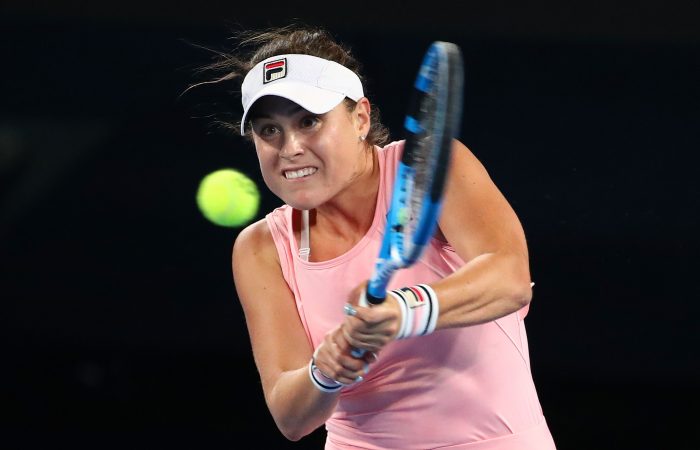Kimberly Birrell: Learning to overcome setbacks
Australian player Kimberly Birrell gives an insight into the challenges an athlete faces when injured.
Gold Coast, Queensland, 31 May 2020 | Kimberly Birrell

Kimberly Birrell is an Australian player who reached the Australian Open third round in 2019 and set a career-high singles ranking of No.154 later that year. An elbow injury has twice since sidelined the 22-year-old from Queensland early in her career, but she is determined to return to tour. Birrell shares her experience and the lessons she has learnt while dealing with injury setbacks …
As a professional athlete I put my body on the line. Day in and day out, I strive to push myself to and past my physical and mental limits, even if I’m tired or hurting. Call me crazy, but it’s that ‘push’ – those tough days and three-set matches that may or may not have put a few extra grey hairs on the heads of my parents and coaches – that I really love about tennis.
Unfortunately playing high-level sport comes with the seemingly unavoidable side effect of injury and we can only hope to keep these minor and infrequent. Most injuries are small bumps in the road, minor disturbances with little-to-no effect to training or playing schedules. Others can turn your life upside down and prove a little harder to navigate.
My story with injury starts in 2016 at a tournament in Canberra. After a long week of matches in tough and windy conditions, my body was feeling the effects, particularly my elbow.
Fast forward four years, two surgeries and eight months without touching a racquet – here I am. It’s taken more than a few tissue boxes to get through the sadness, frustration, doubt, isolation and uncertainty I’ve felt while working through my injury.
Although it might sound like a less than exciting experience, it hasn’t all been totally negative. I can confidently say I wouldn’t be as good a tennis player as I am today if I hadn’t battled to overcome the adversity and challenges that come with having a long-term injury. It makes me proud to say I’ve persevered with positivity on days when it’s been tough. I’ve used those days to build character and I’ve proven to myself how tough I am – an important trait of any athlete.
The biggest lessons I’ve learnt are:
It’s okay to be sad and it’s okay to be angry. You don’t always have to be the happiest and strongest person in the room. Let those feelings of “why me” and “why now” free. The frustration, uncertainty and fear are inevitable and holding onto them won’t help allow you to move on with the healing process.
Try your best to let go of “could have beens” and “should have beens”. That’s easier said than done, I know. But when it comes to rehabilitation, or training in general, things don’t always go the way you imagined. Everyone’s body heals in it’s own time and it can often be a two-steps forward, one-step back situation. Unfortunately, the backwards steps seem to be what we focus on the most. But if you can let go of the expectation of where you thought you would be, sooner or later you’ll be able to look back and see how far you’ve come.
Instead of working towards one large goal that might seem unattainable and excruciatingly far away, set smaller goals that you are able to tick off daily or weekly. This makes improvement seem greater and more constant. I have found that the feeling of progress is vital to recovery, so having smaller goals can help make rehabilitation feel like normal training. Even if those goals are slower speeds or lower weights than you were at, they are still goals, they are still milestones and they are still progress in the right direction.
Lean on the people around you for support even if it means fighting the urge to isolate yourself. Family, friends, coaches, even other athletes are the greatest support network you can ask for. And just remember, they don’t need to understand what you’re going through to be there for you or take your mind elsewhere when you’re feeling off.
On the tougher days, I found it helped to find inspiration from others who have overcome adversity in their own careers. Two people in particular I’ve always looked up to are Storm Sanders and James Duckworth. Both have had tough battles with long-term injuries and both have come out the other side to enjoy amazing success. Their stories remind me that I’m not alone and that with the right attitude, anything is possible.
“Who am I without my sport?” is a scary question to face when you’ve had your heart and soul invested into something for most of your life. Most athletes have an “all eggs in one basket” approach and this forced timeout can be a valuable opportunity to change that. With the new spare time, you could explore personal and professional development and even use skills you have learnt through sport in a new way such as teaching the next generation as a coach or mentor.
Whether it’s a small niggle or a more serious injury, everyone’s journey to recovery is uniquely their own. More often than not, this is accompanied by emotional pain. From my experience the struggles and setbacks have only proven what I can overcome and how hard I am willing to fight to reach my potential as a tennis player. I am eternally grateful for my family, friends and everyone who has supported me along the way so that I can keep doing what I love and be injury free.